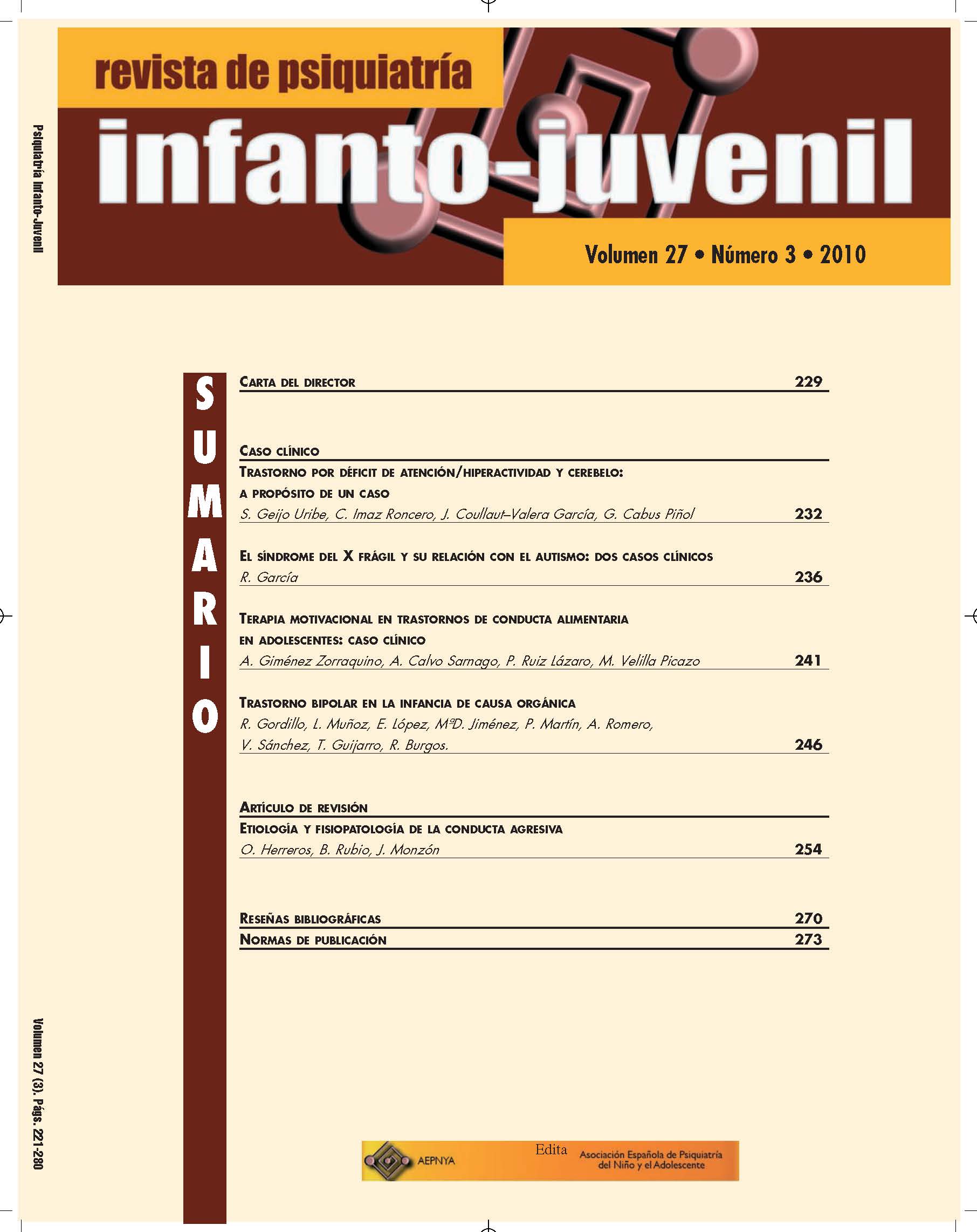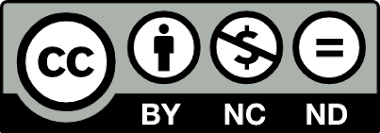Trastorno bipolar en la infancia de causa orgánica
Descargas
Publicado
Cómo citar
Número
Sección
Palabras clave:
Enfermedad mental, bases orgánicas, trastorno bipolarResumen
La búsqueda de las bases orgánicas de las enfermedades mentales es uno de los objetivos históricos de la psiquiatría. Frente a otros supuestos etiológicos de difícil verificación, la constatación de bases orgánicas acerca a la psiquiatría al resto de las especialidades médicas. Dicha disfunción puede ser primaria (si afecta al cerebro de manera directa o selectiva) o secundaria (si la disfunción afecta a diversos órganos o sistemas, entre ellos el cerebro). La comunicación de Casos Clínicos en los que se evidencia la conexión entre el substrato lesional y la expresión psicopatológica puede resultar ilustrativa y, en ocasiones, orientar futuras investigaciones. Presentamos dos Casos Clínicos de sintomatología sugerente de Trastorno Bipolar en la infancia, secundarios ambos a causa orgánica.
Descargas
Citas
2. OMS. Clasificación de los trastornos mentales y del comportamiento, CIE-10. Panamericana, 2000.
3. American Psychiatric Association. Manual diagnóstico y estadístico de los trastornos mentales. Texto revisado. Masson, 2002.
4. Madaan V, Soutullo C, Figueroa A, Escamilla I, Chang K: Enfermedad bipolar. En Soutullo C y Mardomingo MJ (coords.): Manual de psiquiatría del niño y del adolescente. Panamericana, 2010.
5. Soutullo C, Chang K, Díez A, Figueroa A, Escamilla I, Rapado M, Ortuño F: Bipolar disorder in children and adolescents: international perspective on epidemiology and phenomenology. Bipolar Disord, 2005; 7: 497-506.
6. Pauvuluri MN, Birmaher B, Taylor MW: Bipolar disorder: a review of the past 10 years. J Am Acad Child Adolesc Psychiatry, 2005; 44 (9): 846-871.
7. Soutullo C, Escamilla I, Wozniak J, Gamazo P, Figueroa A, Biederman J: Phenomenology of pediatric bipolar disorder in a spanish simple: features before and at the moment of diagnosis. J Affect Disord, 2009; 118 (1-3): 39-47.
8. Bryant RA, O’Donnell ML, Creamer M, et al. The psychiatric sequelae of traumatic injury. Am J Psychiatry 2010; 167 (3): 312-320.
9. Fann JR, Burington B, Leonetti A et al. Psychiatric illness following traumatic brain injury in adults health maintenance organization population. Arch Gen Psychiatry 2004; 61: 53-61.
10. Anstey KJ, Butterworth P, Jorm AF et al. A population survey found an association between self-reports of traumatic brain injury and increased psychiatric symptoms. J Clin Epidemiol 2004; 57: 1202-1209.
11. Nicholl J, LaFrance WC. Neuropsychiatric sequelae of traumatic brain injury. Semin Neurol 2009; 29: 247-255.
12. Jorge RE, Robinson RG, Moser D, Tateno A, Crespo-Facorro B, Arndt S. Major depression following traumatic brain injury. Arch Gen Psychiatry 2004; 61 (1): 42-50.
13. Mortensen PB, Mors O, Frydemberg M, Ewald H. Head injury as a risk factor for bipolar affective disorder. J Affect Disord 2003; 76: 79-83.
14. Jorge RE, Robinson RG, Starkstein SE et al. Secondary mania following traumatic brain injury. Am J Psychiatry 1993; 150: 916-921.
15. Mustafa B, Evrim O, Sari A. Secondary mania following traumatic brain injury. J Neuropsychiatry Clin Neurosci 2005; 17: 122-124.
16. Shukla S, Cook BL, Mukherjee S, Godwin C, Miller MG. Mania following head trauma. Am J Psychiatry 1987; 144: 93-6.
17. Oster TJ, Anderson CA, Filley CM et al. Quetiapine for mania due to traumatic brain injury. CNS Spectr 2007; 12 (10): 764-769.
18. Starkstein SE, Pearlson GD, Boston J, Robinson RG. Mania after brain injury. Arch Neurol 1987; 44: 1069-73.
19. Starkstein SE, Mayberg HS, Berthier ML, Fedoroff P, Price TR, Dannals RF, et al. Mania after brain injury: neuroradiological and metabolic findings. Ann Neurol 1990; 27: 652-9.
20. Starkstein SE, Fedoroff P, Berthier ML, Robinson RG. Manic-depressive and pure manic states after brain lesions. Biol Psychiatry 1991; 29: 149-58.
21. Benke T, Kurzthaler I, Schmidauer Ch, Moncayo R, Donnemiller E. Mania caused by a diencephalic lesion. Neuropsychologia 2002; 40 (3): 245-52.
22. Clark AF, Davidson K. Mania following head injury. A report of two cases and a review of the literature. Br J Psychiatry 1985; 150: 841-4.
23. Yatham LN, Benbow JC, Jeffers AM. Mania following head injury. Acta Psychiatr Scand 1988; 77: 359-60.
24. Markowitz JC. Rap and mania. J Clin Psychiatry 1999; 60: 554-5.
25. Sagduyu K. Association of mild traumatic brain injury with bipolar disorder. J Clin Psychiatry 2002; 63 (7): 594.
26. Max JE, Smith WL Jr, Sato Y, Mattheis PJ, Castillo CS, Lindgren SD, et al. Traumatic brain injury in children and adolescents: psychiatric disorders in the first three months. J Am Acad Child Adolesc Psychiatry 1997; 36: 94-102.
27. Max JE, Koele SL, Smith WL Jr, Sato Y, Lindgren SD, Robin DA, et al. Psychiatric disorders in children and adolescents after severe traumatic brain injury: a controlled study. J Am Acad Child Adolesc Psychiatry 1998; 37: 832-40.
28. Greene MB, Frank J, Kremer S, et al. Manic psychosis and auditory hallucinations following traumatic brain injury in a 13-year-old-boy. J Clin Psychiatry. 2010; 71: 506-7.
29. Sinanan K. Mania as sequel to road accident. Br J Psychiatry 1984; 144: 330-1.
30. Khanna S, Srinath S. Symptomatic mania after minor head injury. Can J Psychiatry 1985; 30 (3): 236-7.
31. Joshi P, Capozzoli JA, Coyle JT. Effective management with lithium of a persistent, post-traumatic hypomania in a 10 year old child. J Dev Behav Pediatr 1985; 6: 352-4.
32. Sayal K, Ford T, Pipe R. Case study: bipolar disorder after head injury. J Am Acad Child Adolesc Psychiatry 2000; 39: 525-8.
33. Lin LC. Mania following left hemisphere injury. Singapore Med J 1996; 37 (4): 448-50.
34. Starkstein SE, Robinson RG. Affective disorders and cerebral vascular disease. Br J Psychiatry. 1989; 154: 170-82.
35. Robinson RG, Kubos KG, Starr LB. Mood disorders in stroke patients: the importance of location of lesion. Brain. 1984; 107: 81-93.
36. Robinson RG, Starkstein SE, Boston JD, Price TR. Comparison of mania and depression after brain injury: causal factors. Am J Psychiatry. 1988; 145: 172-8.
37. Cummings JL, Mendez MF. Secondary mania with focal cerebrovascular lesions. Am J Psychiatry. 1984; 141: 1084-7.
38. Drake ME, Pakainis A, Phillips B. Secondary mania after ventral pontine infarction. J Neuropsychiatry Clin Neurosci. 1990; 2: 322-5.
39. Kotrla KJ, Chacko RC, Barrett SA. A case of organic mania associated with open heart surgery. L Geriatr Psychiatry Neurol. 1994; 7: 8-12.
40. Liu CY, Wang SJ, Fuh JL et al. Bipolar disorder following a stroke involving the left hemisphere. Aust N Z J Psychiatry. 1996; 30: 688-91.
41. Fenn D, George K. Post-stroke mania late in life involving the left hemisphere. Aust N Z J Psychiatry. 1999; 33: 598-600.
42. Alao AO, Chlebowski S, Chung C. Neuropsychiatric systemic lupus erythematosus presenting as bipolar I disorder with catatonic features. Psychosomatics 2009; 50: 543-7.
43. Gross RA, Herridge P. A manic-like illness associated with right 253 frontal arteriovenous malformation. J Clin Psychiatry 1988; 49: 119-20.
44. Hinchey J, Chaves C, Appignani B, Breen J, Pao L, Wang A, Pessin MS, Lamy C, Mas JL, Caplan LR. A reversible posterior leukoencephalopathy syndrome. N Engl J Med. 1996; 334 (8): 494-500.
45. Gümüs H, Per H, Kumandas S, Yikilmaz A. Reversible posterior leukoencephalopathy syndrome in childhood: report of nine cases and review of the literature. Neurol Sci. 2010; 31 (2): 125-31.
46. Beyer JL, Young R, Kuchibhatla M, Krishnan KR. Hyperintense MRI lesions in bipolar disorder: A meta-analysis and review. Int Rev Psychiatry. 2009; 21 (4): 394-409.
47. Kempton MJ, Geddes JR, Ettinger U, Williams SC, Grasby PM. Metaanalysis, database, and meta-regression of 98 structural imaging studies in bipolar disorder. Arch Gen Psychiatry. 2008; 65 (9): 1017-32.
48. DelBello MP, Adler CM, Strakowski SM. The neurophysiology of childhood and adolescent bipolar disorder. CNS Spectr. 2006; 11 (4): 298-311.





 © 2021 AEPNyA Todos los derechos reservados
© 2021 AEPNyA Todos los derechos reservados
